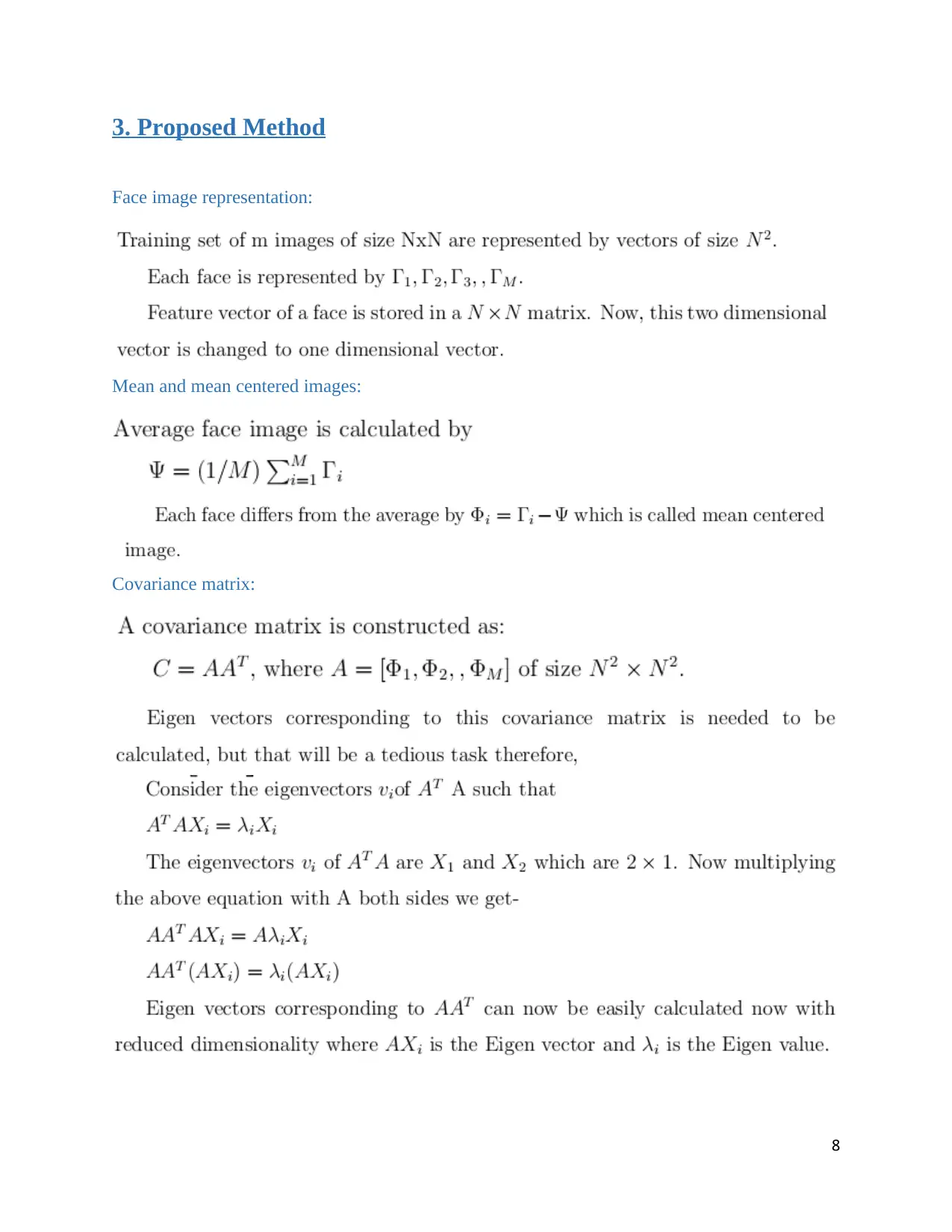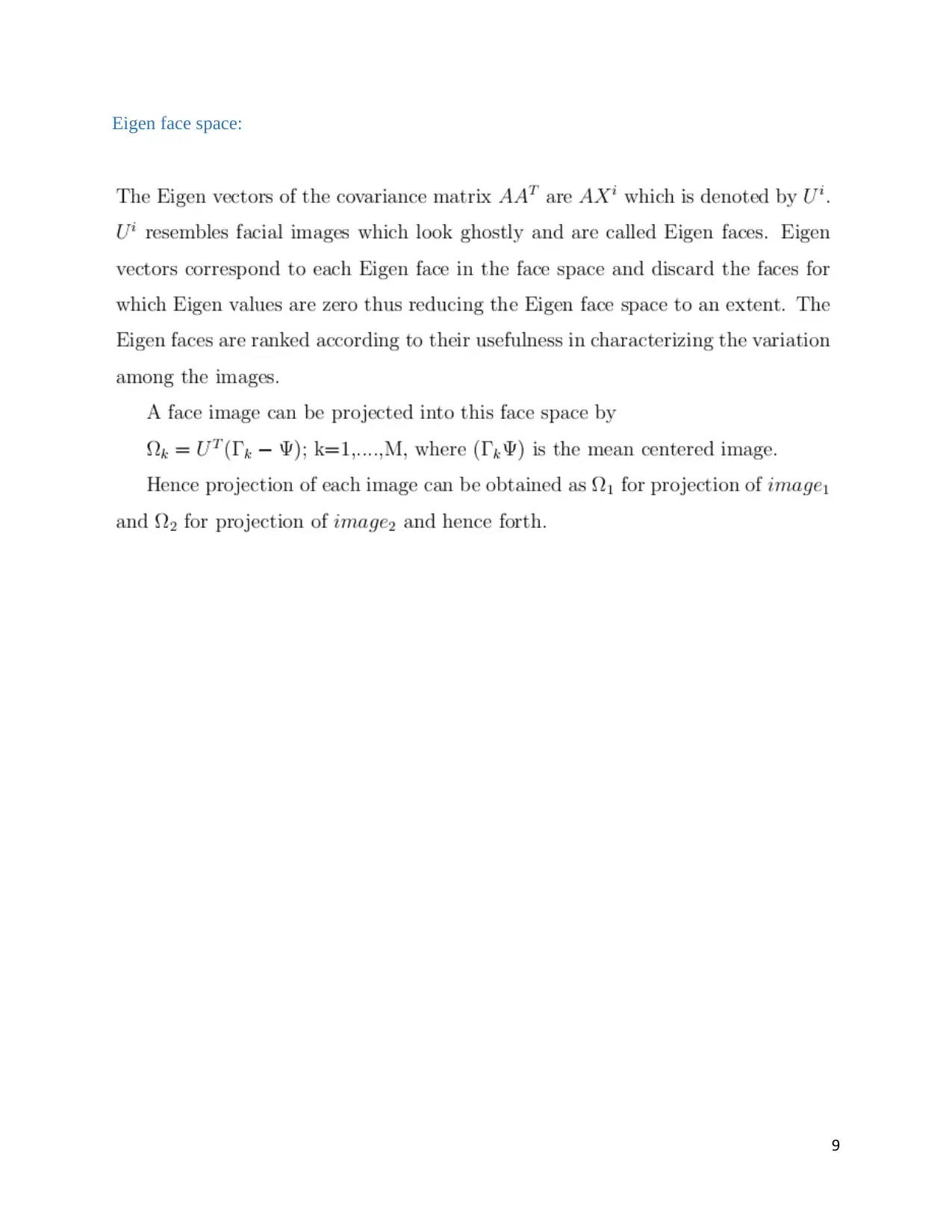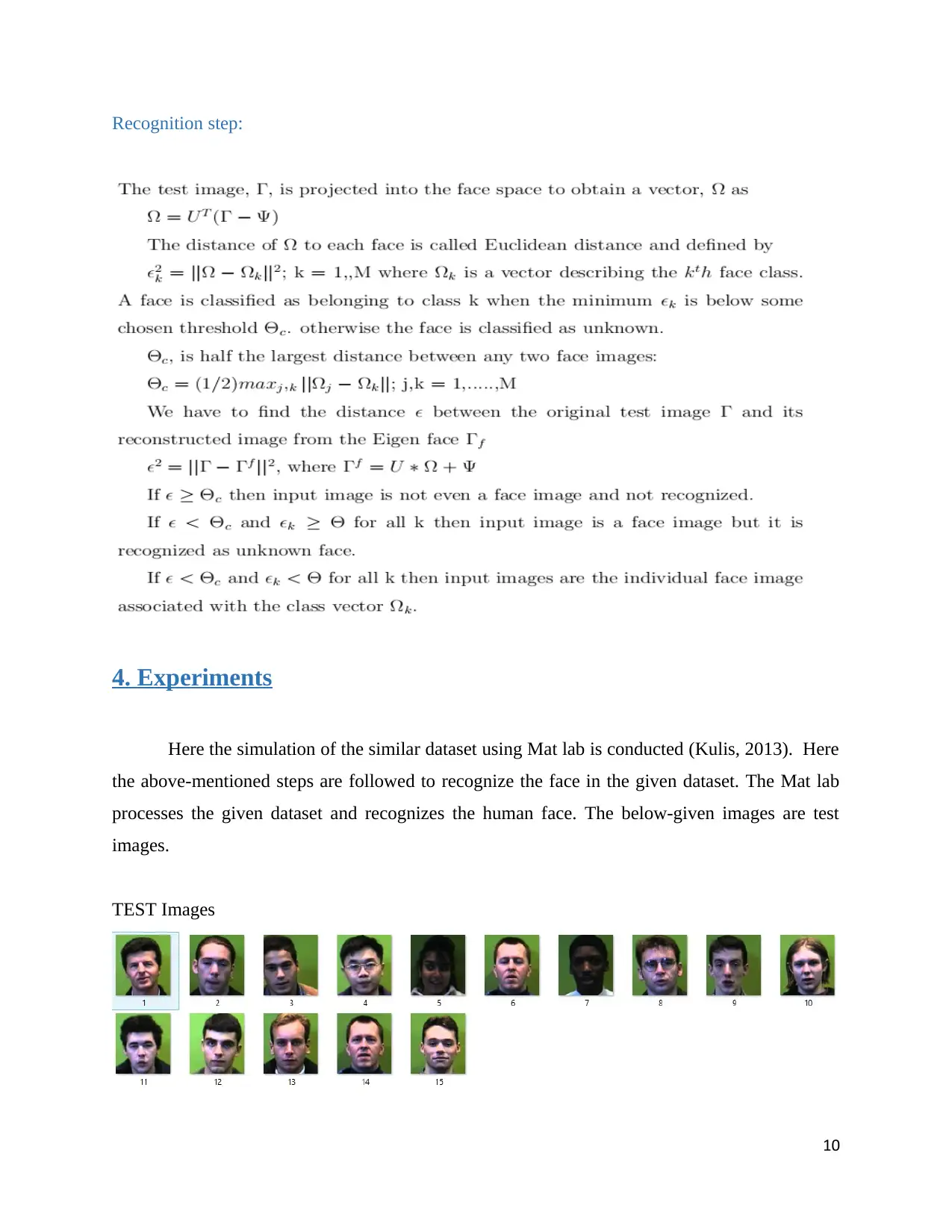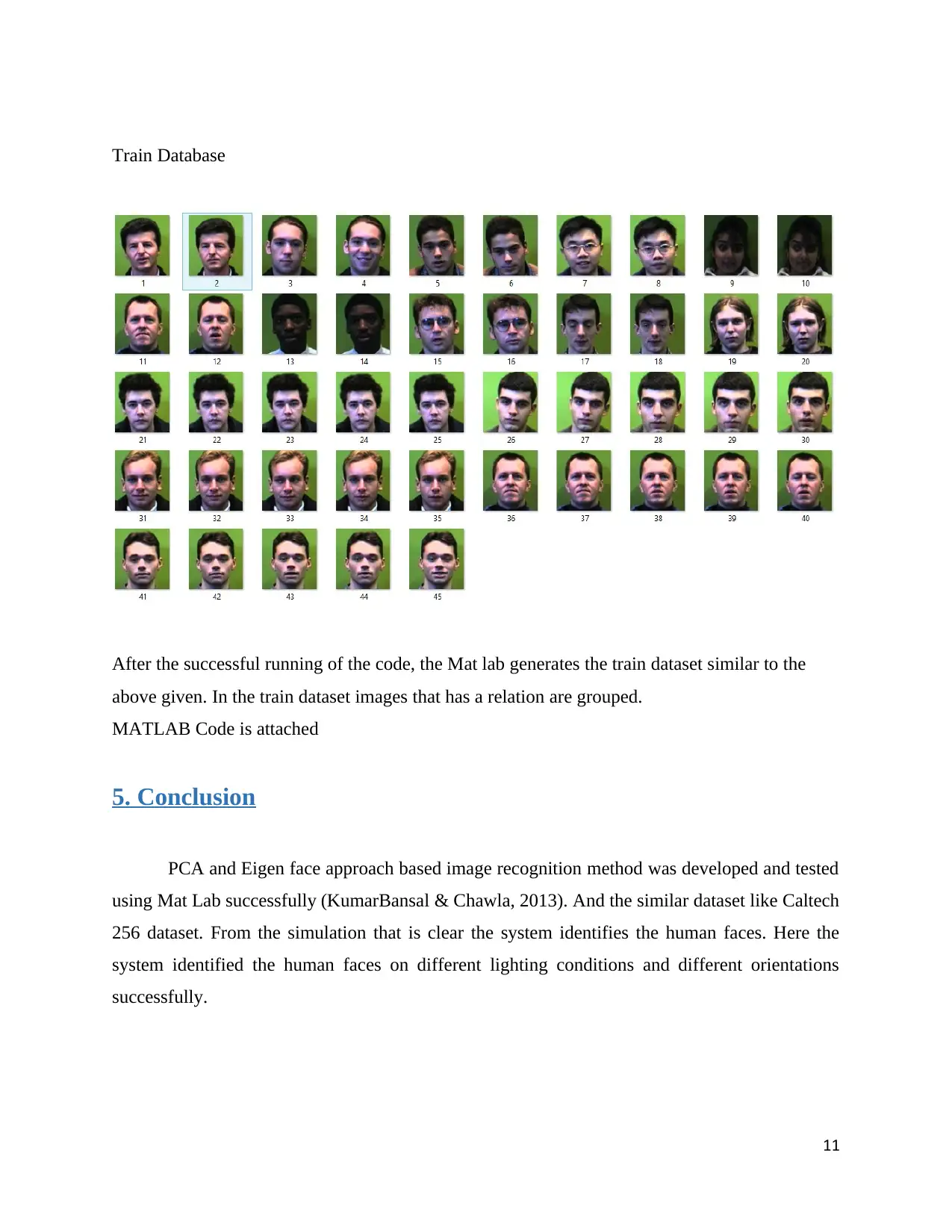CAB420 Machine Learning Project: Face Recognition with PCA Analysis
VerifiedAdded on 2023/03/23
|13
|2712
|68
Project
AI Summary
This project delves into the realm of face recognition using Principal Component Analysis (PCA) and Eigenfaces, leveraging the Caltech 256 dataset and Matlab for simulation and analysis. The project begins with an introduction to biometrics and the significance of face recognition in various applications, followed by a review of related works, including PCA and its application in dimensionality reduction. The proposed method outlines the steps involved in face image representation, including the calculation of mean and mean-centered images, covariance matrices, and the creation of Eigenface space. The recognition step is also described. The project then details the experimental setup using Matlab to simulate the dataset and recognize faces. The report covers the key concepts of PCA, including standardization, covariance matrix computation, and feature vector selection. The project aims to provide a comprehensive understanding of face recognition techniques, emphasizing the practical implementation and analysis of PCA and Eigenfaces, supported by the use of Matlab for image processing and dataset analysis. The final goal is to show how PCA and Eigenfaces can be used for effective face recognition.

Machine Learning – CAB420
Paraphrase This Document
Need a fresh take? Get an instant paraphrase of this document with our AI Paraphraser

Table of Contents
1. Introduction................................................................................................................................2
2. Related works.............................................................................................................................3
PCA..............................................................................................................................................3
Recognition..................................................................................................................................5
Eigen values and Eigen vectors...................................................................................................7
Eigen Faces..................................................................................................................................7
3. Proposed Method.......................................................................................................................8
Face image representation:...........................................................................................................8
Mean and mean centered images:................................................................................................8
Covariance matrix:.......................................................................................................................8
Eigen face space:..........................................................................................................................9
Recognition step:........................................................................................................................10
4. Experiments..............................................................................................................................10
5. Conclusion................................................................................................................................11
References.....................................................................................................................................12
1
1. Introduction................................................................................................................................2
2. Related works.............................................................................................................................3
PCA..............................................................................................................................................3
Recognition..................................................................................................................................5
Eigen values and Eigen vectors...................................................................................................7
Eigen Faces..................................................................................................................................7
3. Proposed Method.......................................................................................................................8
Face image representation:...........................................................................................................8
Mean and mean centered images:................................................................................................8
Covariance matrix:.......................................................................................................................8
Eigen face space:..........................................................................................................................9
Recognition step:........................................................................................................................10
4. Experiments..............................................................................................................................10
5. Conclusion................................................................................................................................11
References.....................................................................................................................................12
1

1. Introduction
For finding the person while the user asks for accessing the resource of the particular
network the biometrics are used mainly. The main purpose of usage of biometrics is finding the
person to verifying whether the person who is accessing the network is the same person as
logged in. the biometrics may include the face structure, eye color, finger structure, etc. the
comparison will be done using the existing data of the person and the data of the person who are
accessing the network now ("A Comparative Studyon Kernel PCA and PCA Methods for Face
Recognition", 2016).
The biometrics will have many types such as face recognition, face detection, fingerprint
detection, eye recognition, eye color recognition, etc. it will be varied to human by the human in
the environment (Agarwal, 2016). This biometrics will be used in many of the systems such as
surveillance system person identification, identification in criminal acts, etc. this is not
changeable. This data cannot be lost. It is different for all peoples.
Here we need to carry out the research using the provided Caltech 256 dataset. The
provided dataset contains 256 object categories. The given dataset is too big. So that we used a
similar dataset with less amount of data. So that we can simulate that in Mat lab. For analyzing
the Caltech 256 dataset Mat lab requires a huge time bound. But the developed solution capable
of processing the Caltech 256 dataset also (Bottou, 2013).
The image recognition is well known for logos, buildings, people, objects, places and
other variables in the images. The vast amount of information is shared by the users through
social networks, apps and websites. Apart from this the mobile phones are also well equipped
these days with cameras which are becoming limitless sharing of digital videos and images.
With the help of huge data the companies are offering smart services for the people who are
using it.
Image recognition refers to as a method to recognize and identify an object or a feature in
a digital image or a video; it is also a section of computer vision. It consist of processing,
2
For finding the person while the user asks for accessing the resource of the particular
network the biometrics are used mainly. The main purpose of usage of biometrics is finding the
person to verifying whether the person who is accessing the network is the same person as
logged in. the biometrics may include the face structure, eye color, finger structure, etc. the
comparison will be done using the existing data of the person and the data of the person who are
accessing the network now ("A Comparative Studyon Kernel PCA and PCA Methods for Face
Recognition", 2016).
The biometrics will have many types such as face recognition, face detection, fingerprint
detection, eye recognition, eye color recognition, etc. it will be varied to human by the human in
the environment (Agarwal, 2016). This biometrics will be used in many of the systems such as
surveillance system person identification, identification in criminal acts, etc. this is not
changeable. This data cannot be lost. It is different for all peoples.
Here we need to carry out the research using the provided Caltech 256 dataset. The
provided dataset contains 256 object categories. The given dataset is too big. So that we used a
similar dataset with less amount of data. So that we can simulate that in Mat lab. For analyzing
the Caltech 256 dataset Mat lab requires a huge time bound. But the developed solution capable
of processing the Caltech 256 dataset also (Bottou, 2013).
The image recognition is well known for logos, buildings, people, objects, places and
other variables in the images. The vast amount of information is shared by the users through
social networks, apps and websites. Apart from this the mobile phones are also well equipped
these days with cameras which are becoming limitless sharing of digital videos and images.
With the help of huge data the companies are offering smart services for the people who are
using it.
Image recognition refers to as a method to recognize and identify an object or a feature in
a digital image or a video; it is also a section of computer vision. It consist of processing,
2
⊘ This is a preview!⊘
Do you want full access?
Subscribe today to unlock all pages.

Trusted by 1+ million students worldwide

gathering of data and analyzing the data which is extracted from the real world. The data which
is taken is a high-dimensional and also makes symbolic information or numerical form while
taking up the decisions. Excluding the image recognition the other things which are included in
computer vision are object recognition, image reconstruction, event detection and also video
tracking.
Looking it with a business perspective, big uses of image recognition are namely
recognition of face, surveillance and security, sight geo location, material recognition, action
recognition, code recognition, factory automation, picture analysis in health and chauffeur
assistance. These uses are forming growth opportunities in various areas. Let us now take a look
at how a revolution been created in a few business sectors because of image recognition.
2. Related works
PCA
Karl Pearson in 1901 invented the Principal component analysis (PCA). PCA is reduction
(variable) process and helpful in the cases when the data obtained contains some redundancy.
This will make sure that variables are reduced into smaller amount of variables which are known
Principal Components that will account for majority of the variance found in the observed
variable.
If we want to use recognition for higher dimensional space there could be a problem which can
arise. The main objective of PCA is to lower down the dimensionality of the information through
retaining some of the variables as they are in original data set. Apart from this there will be an
information loss if hand dimensionality is done. Through the best principal components the low
dimensional space can be calculated.
The benefit of PCA is that it can be used in Eigen face approach which will assist in
lowering the dimension of the database which will be used to identify in a test image. The
storage of the images is in the form of feature vectors in database and they keep moving out as
3
is taken is a high-dimensional and also makes symbolic information or numerical form while
taking up the decisions. Excluding the image recognition the other things which are included in
computer vision are object recognition, image reconstruction, event detection and also video
tracking.
Looking it with a business perspective, big uses of image recognition are namely
recognition of face, surveillance and security, sight geo location, material recognition, action
recognition, code recognition, factory automation, picture analysis in health and chauffeur
assistance. These uses are forming growth opportunities in various areas. Let us now take a look
at how a revolution been created in a few business sectors because of image recognition.
2. Related works
PCA
Karl Pearson in 1901 invented the Principal component analysis (PCA). PCA is reduction
(variable) process and helpful in the cases when the data obtained contains some redundancy.
This will make sure that variables are reduced into smaller amount of variables which are known
Principal Components that will account for majority of the variance found in the observed
variable.
If we want to use recognition for higher dimensional space there could be a problem which can
arise. The main objective of PCA is to lower down the dimensionality of the information through
retaining some of the variables as they are in original data set. Apart from this there will be an
information loss if hand dimensionality is done. Through the best principal components the low
dimensional space can be calculated.
The benefit of PCA is that it can be used in Eigen face approach which will assist in
lowering the dimension of the database which will be used to identify in a test image. The
storage of the images is in the form of feature vectors in database and they keep moving out as
3
Paraphrase This Document
Need a fresh take? Get an instant paraphrase of this document with our AI Paraphraser

trained image in Eigen faces. In order to lower down the dimensionality of a huge dataset Eigen
face approach is applied.
PCA stands for Principle Component Analysis. This is one of the frequently used
technique is big data analysis etc. This method is mainly used for dimensionality reduction. It is
most often used in the process of reducing the dimensionality of the very big datasets. Here the
dimensionality reduction achieved by converting the large set of variables into the smaller one.
But this method doesn't affect the information in the large dataset. In general, the reduction of the
number of variables results in the loss of accuracy. But in PCA it remains in the acceptable level.
And also the method simplifies the entire process. Because analysis of small dataset with less
number of variables is quite easier than the big dataset with a large number of variable (Deng,
Hu, Wu & Guo, 2017). In this section of the report the step by step procedure for carrying out the
PCA process. This process has four steps. And they are explained in the below context.
1. Standardization - Standardization is the first step in the PCA method. This method is
carried out in the initial stage. The main intention of carrying out the standardization
process is to standardize the continuous initial variables. Here the standardization mainly
carried out to resolve the problems raised because of the large difference between the
initial variables. Mathematical formula used for the standardization is given below.
2. Covariance matrix computation -This process is initiated after completing the
standardization process. This process is carried out to find the difference between the
input data set. This method helps to find the relationship between the variables. Here the
covariance matrix is a p X p symmetric matrix similar to the below given one. An
example of the covariance matrix is given below.
4
face approach is applied.
PCA stands for Principle Component Analysis. This is one of the frequently used
technique is big data analysis etc. This method is mainly used for dimensionality reduction. It is
most often used in the process of reducing the dimensionality of the very big datasets. Here the
dimensionality reduction achieved by converting the large set of variables into the smaller one.
But this method doesn't affect the information in the large dataset. In general, the reduction of the
number of variables results in the loss of accuracy. But in PCA it remains in the acceptable level.
And also the method simplifies the entire process. Because analysis of small dataset with less
number of variables is quite easier than the big dataset with a large number of variable (Deng,
Hu, Wu & Guo, 2017). In this section of the report the step by step procedure for carrying out the
PCA process. This process has four steps. And they are explained in the below context.
1. Standardization - Standardization is the first step in the PCA method. This method is
carried out in the initial stage. The main intention of carrying out the standardization
process is to standardize the continuous initial variables. Here the standardization mainly
carried out to resolve the problems raised because of the large difference between the
initial variables. Mathematical formula used for the standardization is given below.
2. Covariance matrix computation -This process is initiated after completing the
standardization process. This process is carried out to find the difference between the
input data set. This method helps to find the relationship between the variables. Here the
covariance matrix is a p X p symmetric matrix similar to the below given one. An
example of the covariance matrix is given below.
4

Here the covariance is positive than the two variables are called as correlated variables.
They are directly proportional to each other. If the covariance value is negative, both
variables have inverse relation among them. They are termed as the inverse correlated
matrix ("face recognition", 2018).
3. Computation of eigen vectors and eigen values covariance - The linear algebra concept
for performing the computation of covariance of eigenvectors and eigenvalues is to find
the principal components of the specified information. Managing the data in principle
component have some phases, the main focus is without eliminating data for reducing the
dimensionality. The principal components do not have the meaning and it is interpretable
in very fewer timings. The lines in the geometric functionality have more amount of data.
The principal components are the new dimension to provide a better angle to view and
expand the information’s which it contains ("Face Recognition using Discriminant Face
Features Extraction method", 2017).
4. Feature vector - This process allows identifying the components in the finding process of
the significance. He main works to do is select either to choose all the components or to
eliminate all the components to obtain the significance. The other vector which is not
selected is called a feature vector. The process is we have to choose only ‘p’ number of
eigenvectors out of the total of ‘n’ vectors. The last data set what we have is ‘p’
dimensions.
There are many forms of feature vector in the domain of image processing. In each pixel
of an image, it expresses the value of the intensity in the particular image. By using this
feature vector, we can also compute the value for the complex image representations.
Recognition
The human face structure is multidimensional and it is complex, there is a necessity of
better technologies for computing the recognition. In social life for individuals face is the most
important identity, which gives more attention to everyone in society. A normal human may look
5
They are directly proportional to each other. If the covariance value is negative, both
variables have inverse relation among them. They are termed as the inverse correlated
matrix ("face recognition", 2018).
3. Computation of eigen vectors and eigen values covariance - The linear algebra concept
for performing the computation of covariance of eigenvectors and eigenvalues is to find
the principal components of the specified information. Managing the data in principle
component have some phases, the main focus is without eliminating data for reducing the
dimensionality. The principal components do not have the meaning and it is interpretable
in very fewer timings. The lines in the geometric functionality have more amount of data.
The principal components are the new dimension to provide a better angle to view and
expand the information’s which it contains ("Face Recognition using Discriminant Face
Features Extraction method", 2017).
4. Feature vector - This process allows identifying the components in the finding process of
the significance. He main works to do is select either to choose all the components or to
eliminate all the components to obtain the significance. The other vector which is not
selected is called a feature vector. The process is we have to choose only ‘p’ number of
eigenvectors out of the total of ‘n’ vectors. The last data set what we have is ‘p’
dimensions.
There are many forms of feature vector in the domain of image processing. In each pixel
of an image, it expresses the value of the intensity in the particular image. By using this
feature vector, we can also compute the value for the complex image representations.
Recognition
The human face structure is multidimensional and it is complex, there is a necessity of
better technologies for computing the recognition. In social life for individuals face is the most
important identity, which gives more attention to everyone in society. A normal human may look
5
⊘ This is a preview!⊘
Do you want full access?
Subscribe today to unlock all pages.

Trusted by 1+ million students worldwide

many of the faces in everyday life and we can able to remember the face another one even after
one year.
The face will look different for everyone, we can also find some of the differentiations
such as glasses, beard, hairstyle changes, etc. other than all the recognition of human face is the
major identification. The new techniques of biometric recognition will compare the new data of
the user with the existing data of the specified user. Based on the matches that looked the same
between each data the resource will be available to the user. This techniques such as face
recognition and other biometrics identifications will be implemented by using some set of
algorithms. The algorithms can be chosen based on the efficiency and the scalability in
modifying the data of the biometrics ("Face Recognition Using LTP Algorithm", 2015).
The pc systems will trace the face of the user and compare with the existing data. it will
be more helpful in finding the criminal activities, verifications used in identity, and also in
security systems. In many of the places such as social networks, hosting in websites uses the face
recognition technology for improving security. The related technologies to computer science
domain technologies are the most used one in face recognition.
The extracted features of the face will be matched with the features which are already
stored in the database for checking the similarity. If the recognized new face is looking the same
as the existing face then it shows the details, if not match the system will provide the details as
unknown. If the unknown face appears in the system more than one times means the face data
will be automatically stored in the database for future reference. This procedure will be more
useful for finding the unauthorized attack, and any identifications (Halim et al., 2018). The
technique will be divided into two major parts based on the look, one traces the whole face and
store the data’s in the database, another one will check some of the specified features in the face
and store it in the database such as eyes, nose, cheeks, mouth, etc. the relation between these two
parts of geometric.
6
one year.
The face will look different for everyone, we can also find some of the differentiations
such as glasses, beard, hairstyle changes, etc. other than all the recognition of human face is the
major identification. The new techniques of biometric recognition will compare the new data of
the user with the existing data of the specified user. Based on the matches that looked the same
between each data the resource will be available to the user. This techniques such as face
recognition and other biometrics identifications will be implemented by using some set of
algorithms. The algorithms can be chosen based on the efficiency and the scalability in
modifying the data of the biometrics ("Face Recognition Using LTP Algorithm", 2015).
The pc systems will trace the face of the user and compare with the existing data. it will
be more helpful in finding the criminal activities, verifications used in identity, and also in
security systems. In many of the places such as social networks, hosting in websites uses the face
recognition technology for improving security. The related technologies to computer science
domain technologies are the most used one in face recognition.
The extracted features of the face will be matched with the features which are already
stored in the database for checking the similarity. If the recognized new face is looking the same
as the existing face then it shows the details, if not match the system will provide the details as
unknown. If the unknown face appears in the system more than one times means the face data
will be automatically stored in the database for future reference. This procedure will be more
useful for finding the unauthorized attack, and any identifications (Halim et al., 2018). The
technique will be divided into two major parts based on the look, one traces the whole face and
store the data’s in the database, another one will check some of the specified features in the face
and store it in the database such as eyes, nose, cheeks, mouth, etc. the relation between these two
parts of geometric.
6
Paraphrase This Document
Need a fresh take? Get an instant paraphrase of this document with our AI Paraphraser

Eigen values and Eigen vectors
Eigen Faces
It is an adequate and professional method for use in face identification due to its learning,
speed, and simplicity capability. It is set of Eigenvectors used within the PC vision problem of
human face identification. They refer to a look based approach to face identification that seeks to
capture the variant in a set of face images and use this data to compare and encode images of
person's faces in a holistic way. The finding has to done for the Eigen vectors which are of
covariance matrix or the Principal Components which are in sharing of the faces. Every image
location consists of Eigen vector, so as to show the Eigen vector in the form of the face. Every
face is being shown in the form of linear combination which is of Eigen faces. Thus the total
Eigen faces is equal to the total of the face image which is present in the training set. Through
Eigen face you can take out the estimation of faces, higher the Eigen values, and those which are
having the highest variance among the face images. The main reason is of computational
efficiency for taking less Eigen faces.
7
Eigen Faces
It is an adequate and professional method for use in face identification due to its learning,
speed, and simplicity capability. It is set of Eigenvectors used within the PC vision problem of
human face identification. They refer to a look based approach to face identification that seeks to
capture the variant in a set of face images and use this data to compare and encode images of
person's faces in a holistic way. The finding has to done for the Eigen vectors which are of
covariance matrix or the Principal Components which are in sharing of the faces. Every image
location consists of Eigen vector, so as to show the Eigen vector in the form of the face. Every
face is being shown in the form of linear combination which is of Eigen faces. Thus the total
Eigen faces is equal to the total of the face image which is present in the training set. Through
Eigen face you can take out the estimation of faces, higher the Eigen values, and those which are
having the highest variance among the face images. The main reason is of computational
efficiency for taking less Eigen faces.
7

3. Proposed Method
Face image representation:
Mean and mean centered images:
Covariance matrix:
8
Face image representation:
Mean and mean centered images:
Covariance matrix:
8
⊘ This is a preview!⊘
Do you want full access?
Subscribe today to unlock all pages.

Trusted by 1+ million students worldwide

Eigen face space:
9
9
Paraphrase This Document
Need a fresh take? Get an instant paraphrase of this document with our AI Paraphraser

Recognition step:
4. Experiments
Here the simulation of the similar dataset using Mat lab is conducted (Kulis, 2013). Here
the above-mentioned steps are followed to recognize the face in the given dataset. The Mat lab
processes the given dataset and recognizes the human face. The below-given images are test
images.
TEST Images
10
4. Experiments
Here the simulation of the similar dataset using Mat lab is conducted (Kulis, 2013). Here
the above-mentioned steps are followed to recognize the face in the given dataset. The Mat lab
processes the given dataset and recognizes the human face. The below-given images are test
images.
TEST Images
10

Train Database
After the successful running of the code, the Mat lab generates the train dataset similar to the
above given. In the train dataset images that has a relation are grouped.
MATLAB Code is attached
5. Conclusion
PCA and Eigen face approach based image recognition method was developed and tested
using Mat Lab successfully (KumarBansal & Chawla, 2013). And the similar dataset like Caltech
256 dataset. From the simulation that is clear the system identifies the human faces. Here the
system identified the human faces on different lighting conditions and different orientations
successfully.
11
After the successful running of the code, the Mat lab generates the train dataset similar to the
above given. In the train dataset images that has a relation are grouped.
MATLAB Code is attached
5. Conclusion
PCA and Eigen face approach based image recognition method was developed and tested
using Mat Lab successfully (KumarBansal & Chawla, 2013). And the similar dataset like Caltech
256 dataset. From the simulation that is clear the system identifies the human faces. Here the
system identified the human faces on different lighting conditions and different orientations
successfully.
11
⊘ This is a preview!⊘
Do you want full access?
Subscribe today to unlock all pages.

Trusted by 1+ million students worldwide
1 out of 13
Your All-in-One AI-Powered Toolkit for Academic Success.
+13062052269
info@desklib.com
Available 24*7 on WhatsApp / Email
![[object Object]](/_next/static/media/star-bottom.7253800d.svg)
Unlock your academic potential
Copyright © 2020–2025 A2Z Services. All Rights Reserved. Developed and managed by ZUCOL.


